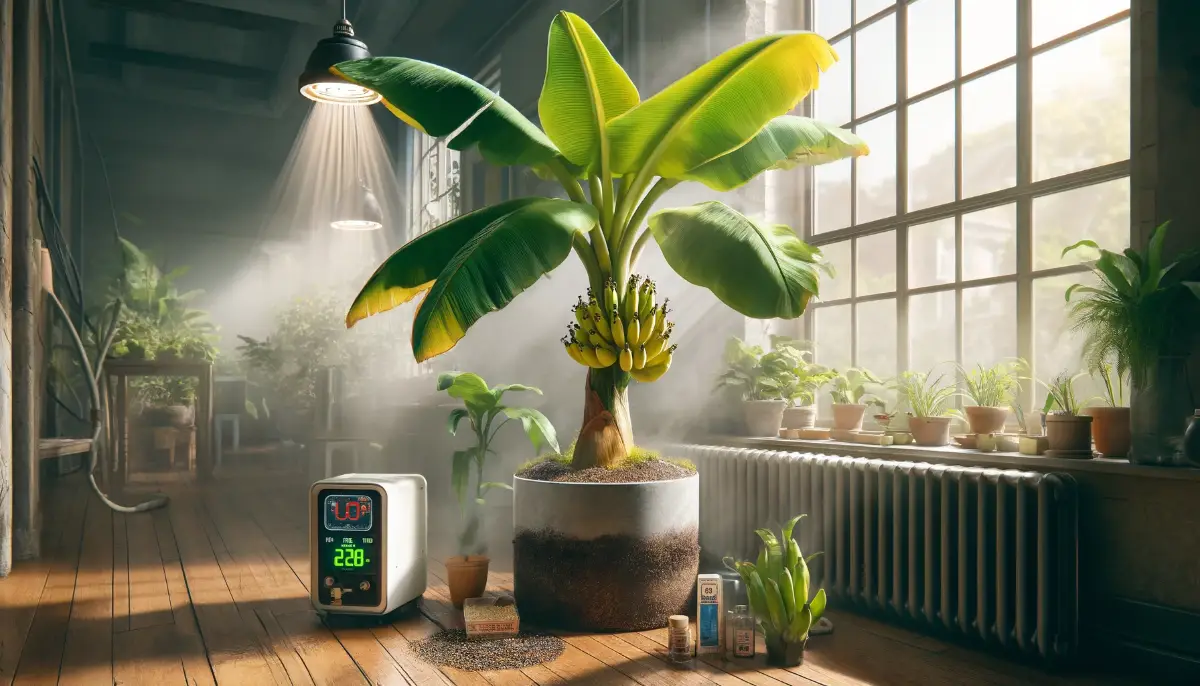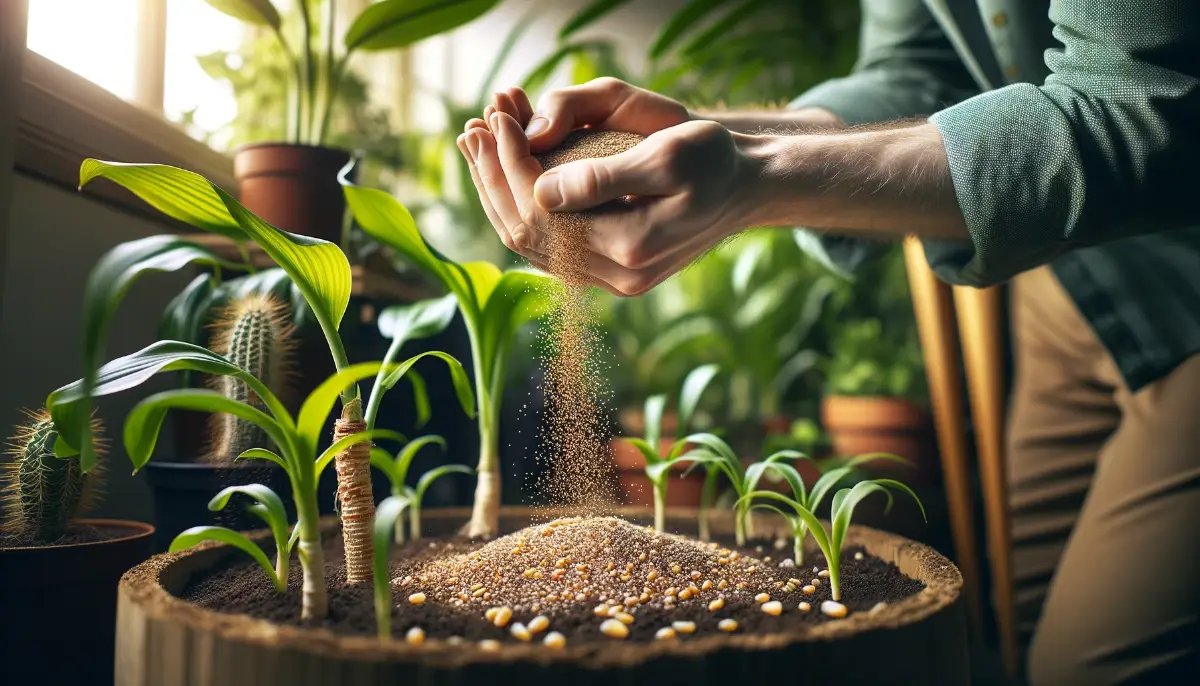Growing avocados at home, especially in containers, offers a range of benefits and is surprisingly adaptable to limited spaces.
Not only does this approach enable you to enjoy the freshest possible avocados, but it also adds a touch of greenery to your home environment.
Avocado plants can thrive in pots, making them ideal for urban gardeners or those with limited garden space.
They require specific care, such as proper sunlight, watering, and fertilization, but with attention to these details, you can cultivate a productive tree even on a balcony or patio.
Planting the Avocado Pit
Planting an avocado pit is a fascinating and rewarding way to start your own avocado tree at home, especially if you’re planning to grow it in a container. Here’s a step-by-step guide to get you started:
Preparation of the Avocado Pit
- Begin by removing the pit from an avocado fruit carefully, without cutting it.
- Clean the pit under running water to remove any sticky flesh, being careful not to remove the brown skin on the pit as it protects the seed inside.
Germination
- Insert three to four toothpicks around the circumference of the avocado pit at a slight downward angle. This will allow you to suspend the pit over a glass of water.
- Place the wider end of the pit down so that it is submerged in the water while the toothpicks rest on the brim of the glass. The top half of the pit should be exposed to the air.
- Position the setup in a warm, sunny spot like a windowsill. Change the water regularly to prevent mold and bacteria buildup.
Root and Sprout Development
- Within 2 to 6 weeks, you should start seeing roots emerging from the bottom of the pit, and soon after, a sprout will emerge from the top.
- Once the sprout reaches about six inches tall, it can be pruned back to about three inches to encourage more root growth before potting.
Planting in Soil
- Once the roots are well developed, and the sprout has been pruned, it’s time to plant the pit in a pot.
- Choose a pot with good drainage and fill it with a sandy, loose potting soil. Plant the pit so that the top half remains above the soil surface.
- Water the newly potted pit thoroughly, then place it in a bright location where it will receive indirect sunlight.
Initial Care Post-Planting
- Keep the soil moist but not soggy. Avocado plants are susceptible to overwatering, which can lead to root rot.
- As the plant grows, ensure it receives ample sunlight and consider supplementing with a grow light if natural light is insufficient.
By following these steps, you’ll be well on your way to growing a healthy avocado tree right in your home.
Potting and Initial Care
Once your avocado pit has sprouted and is ready for potting, providing the right care and environment becomes crucial for its growth into a healthy plant. Here’s a detailed guide on how to pot your sprouted avocado pit and ensure its initial care:
Choosing the Right Pot:
Select a pot that is large enough to accommodate the root system of your avocado plant, with extra room for growth. Typically, a pot that is 12 to 18 inches (30cm to 46cm) in diameter is suitable for a young plant.
Ensure the pot has adequate drainage holes to prevent waterlogging, which can lead to root rot.
Soil Preparation:
Avocado trees thrive in loose, sandy, well-draining potting soil. Avoid using heavy garden soil as it can compact and restrict root growth.
Consider mixing in some perlite or vermiculite to improve drainage and aeration in the soil.
Planting the Avocado:
Fill the pot with the prepared potting mix and make a hole in the center deep enough to accommodate the entire root ball of your sprouted avocado pit.
Place the pit in the hole, ensuring that the top half of the pit where the sprout emerges remains above the soil line.
Gently firm the soil around the base of the pit to secure it in place.
Initial Watering:
After planting, water the avocado thoroughly to settle the soil around the roots. Ensure the water drains freely from the bottom of the pot.
Maintain moisture in the soil, but allow the top inch to dry out between waterings to avoid overwatering, which can be detrimental to the plant.
Location and Sunlight:
Place your potted avocado in a location where it will receive ample sunlight. A south-facing window is ideal if growing indoors.
Avocado plants need about 6-8 hours of sunlight per day. If natural light is insufficient, consider using grow lights to supplement light exposure.
Temperature and Environment:
Keep the avocado plant in a warm environment, ideally between 60 to 85 degrees Fahrenheit. Protect it from drafts and extreme temperatures, which can stress the plant.
If possible, during warmer months, you can move the pot outdoors to a sheltered location to benefit from natural sunlight and air circulation.
Watering Your Avocado Tree
Frequency and Amount: Water your avocado tree deeply, allowing the soil to dry slightly between waterings. This helps ensure the roots receive enough moisture without becoming waterlogged, which can lead to root rot. The frequency of watering will depend on the climate, season, and the tree’s growth stage. Generally, young trees require more frequent watering than established ones.
Best Practices: It is recommended to water in the morning or late evening to minimize evaporation and reduce the risk of sun scorch. Ensure that your container has good drainage to prevent excess water from accumulating.
Feeding Your Avocado Tree
Feeding your avocado tree organically involves using natural fertilizers that are better for the environment and often beneficial for the health of your plant. Here are some tips and organic options for nourishing your avocado tree:
Organic Fertilization Methods
Compost: Adding compost to the soil around your avocado tree can provide a rich source of nutrients. Compost not only feeds the tree but also improves soil structure and promotes beneficial microbial activity. Apply a layer of compost around the base of the tree, being careful not to let it touch the trunk directly.
Manure: Well-rotted manure from cows, horses, or chickens is an excellent organic fertilizer. It should be well-composted to avoid burning the plant with excess nitrogen. Like compost, manure also enhances soil quality and fertility.
Fish Emulsion: This is a fast-acting organic fertilizer high in nitrogen, making it ideal for the growth needs of an avocado tree. Fish emulsion should be diluted according to the package directions and can be applied during the growing season to support leaf and branch development.
Seaweed Extract: Seaweed extract is rich in trace minerals and a natural growth stimulant for avocado trees. It can be used as a foliar spray or added to the watering can to soak the roots, promoting overall health and vigor of the tree.
Wood Ash: If you have a wood-burning stove or fireplace, wood ash can be a good source of potassium and other minerals. However, use it sparingly as it can also raise soil pH, which might not be ideal for avocados if the soil is already alkaline.
Best Practices for Organic Feeding
- Regular Feeding: Feed your avocado tree every 6-8 weeks during the growing season. During the dormant season, reduce the frequency as the tree’s nutrient requirements decrease.
- Mulching: Apply organic mulch around the base of the tree to help retain soil moisture and slowly release nutrients into the soil as it decomposes.
- Soil Testing: It’s wise to test your soil every couple of years. Soil tests can help you understand what nutrients are missing and how to adjust your fertilization strategy effectively.
Feeding your avocado tree with organic fertilizers not only supports sustainable gardening practices but also encourages a healthier growth environment. For specific product recommendations and more detailed organic care tips, gardening blogs and organic gardening resources can provide additional insights.
Pruning and Repotting
Pruning and repotting are essential practices for maintaining the health and productivity of your avocado tree, especially when it’s grown in a container. These techniques help manage the plant’s size, encourage healthy growth, and ensure the tree has enough space and nutrients to thrive.
Pruning Your Avocado Tree
Why Prune: Pruning helps control the size of your tree, removes unhealthy or dead branches, and can encourage more fruitful growth. It’s particularly important for container-grown trees to prevent them from becoming root-bound or top-heavy.
When to Prune: The best time to prune an avocado tree is in late winter or early spring before new growth begins. This timing helps the tree heal quickly without risking exposure to extreme cold or heat.
How to Prune: Focus on removing dead or damaged branches first. Then, thin out any branches that are overcrowded to allow light and air to penetrate the canopy, which is essential for the health of the tree. Always use clean, sharp pruning shears to make clean cut.
Repotting Your Avocado Tree
When to Repot: Avocado trees in containers should be repotted every two to three years to prevent the soil from becoming compacted and nutrient-depleted. It’s also necessary to give the growing roots more space.
Choosing a Pot: Select a new pot that is slightly larger than the current one—usually a few inches wider and deeper. Ensure the pot has adequate drainage holes to prevent waterlogging.
Repotting Process:
- Water your avocado tree thoroughly a day before repotting to ease the stress and reduce transplant shock.
- Gently remove the tree from its current pot and inspect the root system. Trim any excessively long or circling roots to encourage new growth.
- Fill the new pot with a mix of fresh potting soil and some organic material like compost. Make sure the soil is well-draining to prevent root rot.
- Place the tree in the new pot and fill around it with soil, tamping down lightly to remove air pockets. Water the tree well after repotting and keep it in a shaded area for a few days to recover.
Both pruning and repotting are vital to keeping your avocado tree healthy and productive. Regularly performing these tasks will help ensure your tree has the best chance to grow vigorously and possibly produce fruit in the future.
Typical Challenges in Avocado Cultivation
Caring for an avocado tree, especially in a container, can sometimes be challenging. Here are some common issues you might encounter and how to troubleshoot them:
Yellowing Leaves
- Cause: Often a sign of overwatering or nutrient deficiency, particularly nitrogen or iron.
- Solution: Adjust your watering schedule to allow the soil to dry out slightly between waterings. Consider soil testing and amend with appropriate nutrients if deficiencies are detected.
Leaf Browning or Curling
- Cause: This can be caused by underwatering, low humidity, or salt buildup from over-fertilization.
- Solution: Increase watering frequency slightly and ensure the tree is not exposed to drafts. If over-fertilization is suspected, leach the soil by running water through it to flush out excess salts.
Stunted Growth or No Fruit Production
- Cause: Inadequate sunlight, improper watering, or lack of pollination can all contribute to these issues.
- Solution: Ensure the tree receives enough sunlight, adjust watering practices, and if growing indoors or with a single tree, consider hand pollinating flowers to encourage fruit set.
Pests and Diseases
- Common Pests: Spider mites, scale, and aphids can attack avocado trees.
- Solution: Use a mild insecticidal soap or neem oil solution to treat infestations. Regularly inspect your tree for signs of pests and treat promptly to prevent spread.
- Diseases: Root rot is a common issue, particularly in poorly draining soils.
- Solution: Ensure good drainage in the pot, avoid overwatering, and use fungicides if necessary.
Dropping Leaves
- Cause: Sudden leaf drop can be a reaction to sudden changes in temperature, light, or watering.
- Solution: Try to keep the environmental conditions around your avocado tree as consistent as possible. Avoid moving the tree frequently between vastly different environments.
Addressing these common issues promptly can help keep your avocado tree healthy and productive. For more specific advice and advanced troubleshooting, visiting specialized gardening websites and forums, or consulting with local gardening experts, can provide additional support.
FAQs about Growing Avocados in Containers at Home
Can I grow an avocado tree from a store-bought avocado?
Yes, you can grow an avocado tree from the pit of a store-bought avocado. Clean and prepare the pit, then suspend it over water using toothpicks until roots appear, after which it can be planted in soil.
How long does it take for an avocado tree to start producing fruit?
Avocado trees grown from seed can take anywhere from 5 to 13 years to produce fruit. However, trees that are grafted and purchased from nurseries may begin producing fruit in as little as 2-3 years.
What is the best soil for growing avocado trees in containers?
The best soil for avocado trees is a loose, well-draining potting mix. Avoid heavy garden soils; instead, opt for a mix designed for citrus or avocado plants, enriched with perlite or vermiculite for better drainage.
How often should I water my potted avocado tree?
Water your avocado tree deeply but allow the soil to dry out slightly between waterings. The frequency will depend on the climate and the season, but generally, it’s crucial not to let the soil become waterlogged.
Do avocado trees need full sun?
Yes, avocado trees thrive in full sun and require at least 6-8 hours of direct sunlight daily. If you’re growing indoors, you may need to supplement with grow lights during darker months.
When is the best time to prune an avocado tree?
The best time to prune an avocado tree is in late winter or early spring before new growth begins. This helps the tree to heal quickly and reduces the risk of stress.
Can I grow an avocado tree indoors?
Yes, avocado trees can be grown indoors, but they require ample sunlight, consistent watering, and proper fertilization. They also need a large enough container to accommodate their growing root system.
What are the signs of overwatering an avocado tree?
Signs of overwatering include yellowing leaves, soft and mushy stems, and a general appearance of wilting or drooping despite moist soil.
How do I know when to repot my avocado tree?
Repot your avocado tree every two to three years or when you notice that the roots have filled the current pot. Signs that it’s time to repot include roots growing through the drainage holes and slower growth.
What should I do if my avocado tree has pests?
Common pests like aphids, spider mites, and scale can be managed using insecticidal soap or neem oil. Apply these treatments according to the instructions, ensuring thorough coverage of all plant parts










